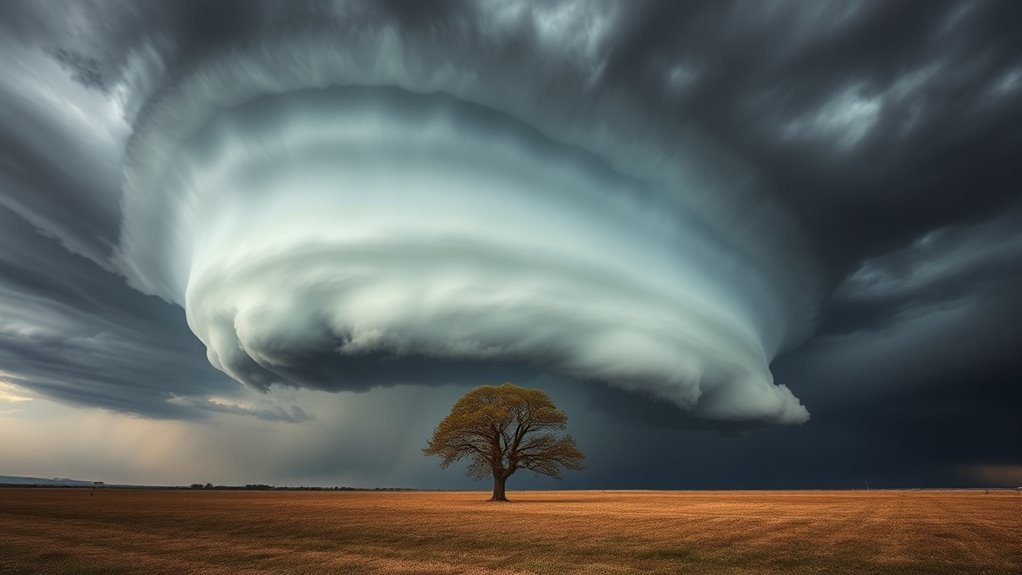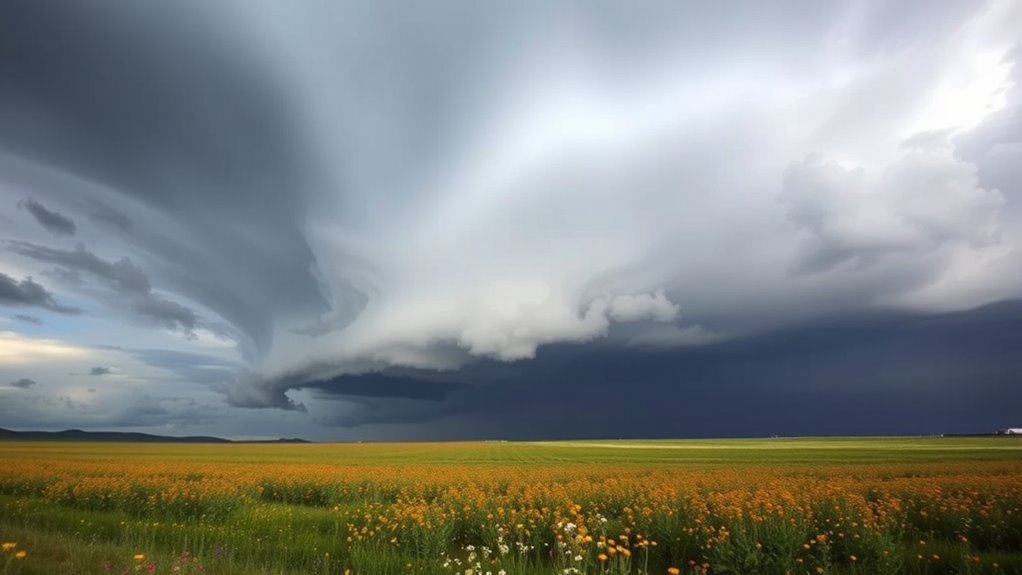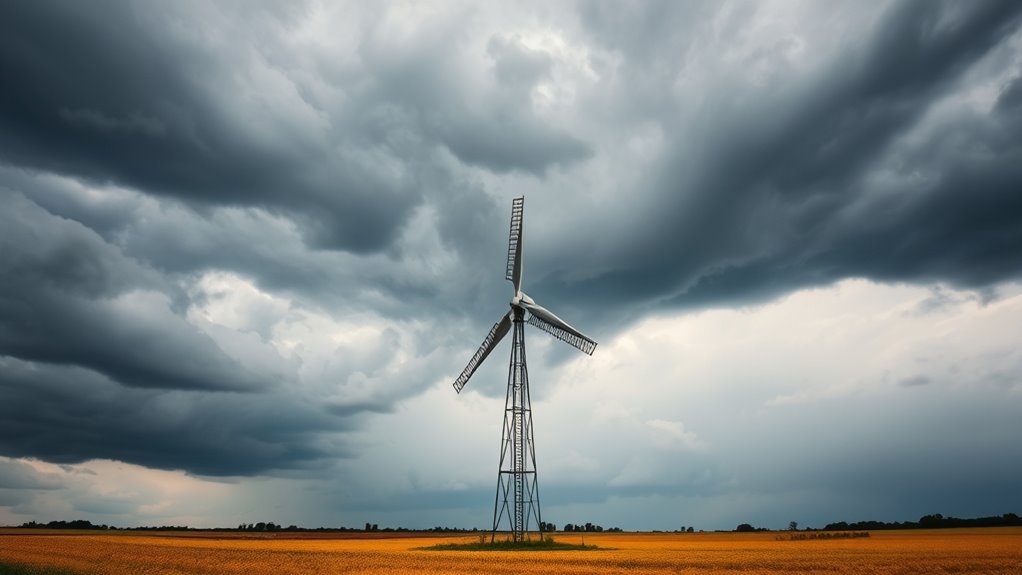Squalls are intense weather events that can create conditions favorable for tornado formation. They often arise from severe thunderstorms, defined by heightened atmospheric instability. This instability fosters strong updrafts and notable temperature gradients, essential for tornado development. Rapid changes in temperature, wind direction, and increased humidity during squalls can amplify the likelihood of tornadoes. Understanding these connections is vital for predicting severe weather patterns and improving safety measures. More observations on this dynamic phenomenon await exploration.
Main Points
- Squalls often precede tornadoes, with sudden weather changes indicating potential severe thunderstorms and instability conducive to tornado formation.
- Rapid uplift of warm, moist air during squalls can create the necessary conditions for tornado development within severe thunderstorms.
- Wind shear associated with squalls improves storm organization and can enhance the likelihood of tornadoes forming from developing supercells.
- The intense weather conditions of squalls, including heavy rainfall and strong winds, can contribute to the emergence of rapidly rotating columns of air, leading to tornadoes.
- Monitoring squall characteristics, such as temperature drops and wind shifts, can provide early warnings for potential tornado activity in affected areas.
Understanding Squalls: Characteristics and Formation
Although squalls can occur at any time of the year, they are most commonly associated with the passage of cold fronts. These weather phenomena are defined by sudden, intense bursts of wind and precipitation, often leading to hazardous conditions.
Squalls typically result from the rapid uplift of warm, moist air when it encounters a cold air mass. This upward motion creates instability in the atmosphere, leading to the formation of cumulonimbus clouds.
As a squall line develops, it can produce powerful winds, heavy rainfall, and even hail. The duration of these events is usually brief, often lasting less than an hour, but their impact can be considerable.
The steep temperature gradient associated with cold fronts intensifies squall activity, making them notable for their unpredictability. Understanding squalls is vital for meteorologists who seek to forecast severe weather and guarantee public safety during sudden storm events.
Tornadoes: Nature's Most Violent Storms

Tornadoes are among the most violent weather phenomena on Earth, defined by their rapidly rotating columns of air that extend from thunderstorm clouds to the ground. These formidable storms can produce winds exceeding 300 miles per hour, resulting in catastrophic damage.
Tornadoes typically form in association with severe thunderstorms, particularly supercells, where specific atmospheric conditions converge.
Key characteristics of tornadoes include:
- Funnel Shape: Tornadoes often appear as a visible funnel, connecting the cloud base to the ground.
- Intensity Scale: The Enhanced Fujita Scale categorizes tornadoes from EF0 to EF5, based on the damage they cause.
- Duration and Path: Tornadoes can last from a few seconds to over an hour, with paths that may extend for several miles.
Understanding these features emphasizes the importance of tornado preparedness and awareness in affected regions.
The Role of Atmospheric Instability
Atmospheric instability plays an important role in the formation of tornadoes, as it dictates the conditions necessary for these violent storms to develop.
Different types of instability, such as surface-based and raised instability, can greatly influence the severity and frequency of tornado activity.
Understanding these dynamics is essential for predicting and mitigating the impacts of tornadoes associated with squall lines.
Types of Atmospheric Instability
Understanding the various types of atmospheric instability is essential for predicting severe weather events, as these instabilities play an important role in storm development.
Atmospheric instability can be categorized into different types, each influencing weather patterns in unique ways.
- Convective Instability: This occurs when warm, moist air rises rapidly, leading to the formation of cumulus clouds and potential thunderstorms.
- Conditional Instability: Present when the atmosphere is stable at lower levels but becomes unstable at higher altitudes, often resulting in severe weather under specific conditions.
- Absolute Instability: Defined by an environment where rising air parcels are always warmer than their surroundings, promoting continuous upward motion and severe storm development.
These instabilities are vital for meteorologists in evaluating the likelihood of severe weather phenomena, including squalls and tornadoes.
Effects on Tornado Formation
While various forms of atmospheric instability greatly influence severe weather development, they play a particularly crucial role in the formation of tornadoes.
Atmospheric instability occurs when warm, moist air at the surface rises and meets cooler, drier air aloft. This temperature difference creates an environment conducive to severe thunderstorms, which can spawn tornadoes.
The presence of wind shear, or changes in wind speed and direction with height, further improves this instability, allowing for the rotation necessary for tornado formation.
When a squall line moves through, the interaction between the advancing cold front and pre-existing warm air can intensify these conditions, increasing the likelihood of rapid tornado development.
Understanding these factors is essential for predicting tornado occurrences and issuing timely warnings.
How Squall Lines Develop

Squall lines typically develop in response to significant temperature and moisture contrasts in the atmosphere. These meteorological conditions create a dynamic environment conducive to the formation of organized line-shaped storms.
Several key factors contribute to the development of squall lines:
- Cold Front Interaction: A cold front can lift warm, moist air ahead of it, promoting instability and leading to the formation of thunderstorms.
- Wind Shear: Variations in wind speed and direction with altitude can improve storm organization, enabling the squall line to sustain itself.
- Moisture Availability: High humidity levels in the lower atmosphere provide the necessary fuel for thunderstorms to develop and maintain intensity.
As these elements interact, squall lines can emerge, often resulting in severe weather phenomena, including heavy rainfall, gusty winds, and potential tornadoes.
Understanding these development mechanisms is essential for predicting severe weather events.
The Mechanism Behind Tornado Formation

Understanding tornado formation involves examining key atmospheric conditions.
Factors such as instability, wind shear, and moisture contribute greatly to the development of powerful updrafts.
These elements interact dynamically, setting the stage for tornadoes to emerge from squall lines.
Atmospheric Instability Factors
Atmospheric instability plays an essential role in the formation of tornadoes, acting as a catalyst for severe weather events. This instability arises when warm, moist air near the surface is overlain by cooler, drier air aloft. The resulting conditions create an environment conducive to rapid upward motion, which is critical for tornado development.
Key factors contributing to atmospheric instability include:
- Temperature Gradient: A notable difference between surface and upper-level temperatures increases instability.
- Humidity Levels: Increased moisture near the surface facilitates buoyancy, allowing air to rise more easily.
- Lift Mechanisms: Fronts and other lifting mechanisms can trigger the necessary upward motion, intensifying instability.
These elements collectively create the conditions under which tornadoes can form rapidly.
Wind Shear Influence
Wind shear, the variation of wind speed and direction with height, greatly influences tornado formation by enhancing the vertical motion necessary for these intense storms to develop.
When wind shear is present, it creates a favorable environment for the formation of rotating updrafts, which are vital in tornado genesis. The difference in wind speeds at various altitudes can lead to the tilting of horizontal vorticity into the vertical plane, allowing for the development of supercell thunderstorms.
These thunderstorms are defined by their rotating nature, which can produce strong, concentrated updrafts. As these updrafts strengthen, the potential for tornado formation increases, demonstrating the significant role wind shear plays in the lifecycle of tornadoes.
Understanding this mechanism is essential for predicting tornado activity.
Moisture and Updrafts
While various factors contribute to tornado formation, moisture plays an essential role in the development of strong updrafts necessary for such intense storms.
When warm, moist air rises and interacts with cooler air aloft, it creates instability in the atmosphere. This instability is critical for the formation of powerful updrafts, which can lead to tornado development. The presence of adequate moisture is indispensable for sustaining these updrafts, allowing them to grow and strengthen.
Key elements include:
- Humidity Levels: High humidity promotes the formation of clouds and precipitation, enhancing updraft strength.
- Temperature Gradients: Warm air at the surface combined with cooler air aloft increases instability.
- Convergence Zones: Areas where air masses collide can intensify updrafts, promoting tornado formation.
Identifying the Signs: Squalls and Tornado Watches
Understanding the signs that precede squalls and tornadoes is essential for ensuring safety during severe weather events. Observers should be aware of specific indicators that can signal the onset of these phenomena. Rapidly changing weather conditions, such as a sudden drop in temperature or increased wind speeds, often accompany squalls.
Additionally, the presence of dark, ominous clouds and a noticeable shift in wind direction can indicate the potential for severe weather.
Tornado watches are issued when conditions favor the development of tornadoes in a given area. These watches are typically accompanied by forecasts of severe thunderstorms and can serve as a critical warning for residents.
It is important to stay informed through local weather updates and alerts, as timely information can greatly improve response and preparedness in the face of impending danger. Recognizing these signs can eventually save lives during severe weather events.
Improving Prediction and Response Strategies
Effective prediction and response strategies are essential for managing the risks associated with squalls and tornadoes. Improved forecasting technologies and methodologies are critical in advancing these strategies. By leveraging advanced meteorological models and data analytics, meteorologists can better anticipate severe weather events.
Additionally, public education plays an important role in guaranteeing communities are prepared.
To enhance prediction and response strategies, the following steps can be implemented:
- Integration of AI and Machine Learning: Utilizing machine learning algorithms can boost the accuracy of weather predictions by analyzing extensive datasets for patterns related to squalls and tornado formation.
- Real-time Communication Systems: Developing efficient communication channels between meteorologists and local authorities guarantees timely dissemination of warnings to affected populations.
- Community Preparedness Programs: Educating citizens about emergency protocols can notably reduce risks and improve response times during severe weather events.
Common Questions
How Can I Prepare My Home for a Squall or Tornado?
To prepare for severe weather events, individuals should secure outdoor items, create an emergency kit, establish a safe room, stay informed through alerts, and develop a communication plan with family and friends for safety.
Are Squalls More Common in Certain Regions?
Squalls are indeed more common in specific regions, particularly along coastal areas and the Great Plains. These locations experience favorable conditions, such as warm, moist air, which contribute to the formation of squall lines.
What Is the Safest Place to Be During a Squall?
During a squall, the safest place to be is indoors, preferably in a basement or an interior room away from windows. This location minimizes exposure to potential debris and high winds associated with severe weather events.
Can Squalls Occur Without Tornadoes?
Squalls can indeed occur without tornadoes. These sudden, intense wind and rain events may arise from various atmospheric conditions, producing strong winds and heavy precipitation without the formation of tornadoes, emphasizing their distinct meteorological characteristics.
How Do Meteorologists Track Squalls and Tornadoes?
Meteorologists utilize advanced radar technology, satellite imagery, and weather models to track squalls and tornadoes. These tools enable them to analyze atmospheric conditions, identify storm patterns, and issue timely warnings to mitigate potential hazards.

